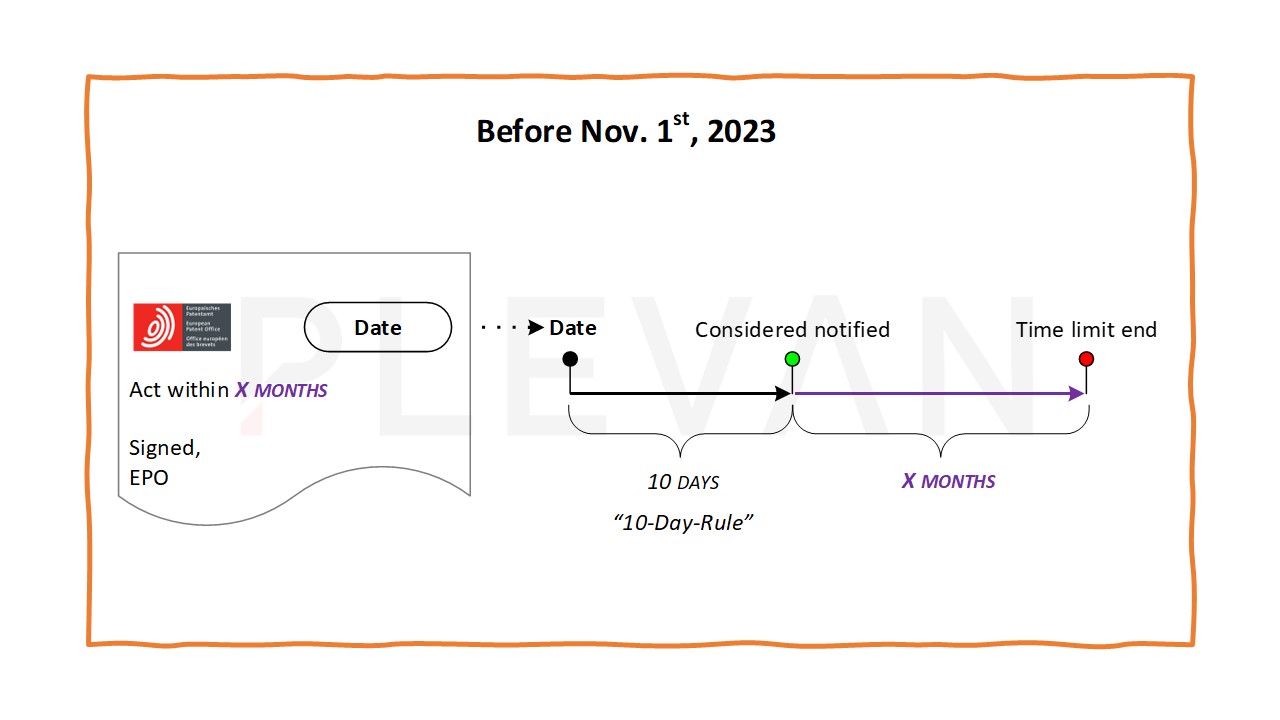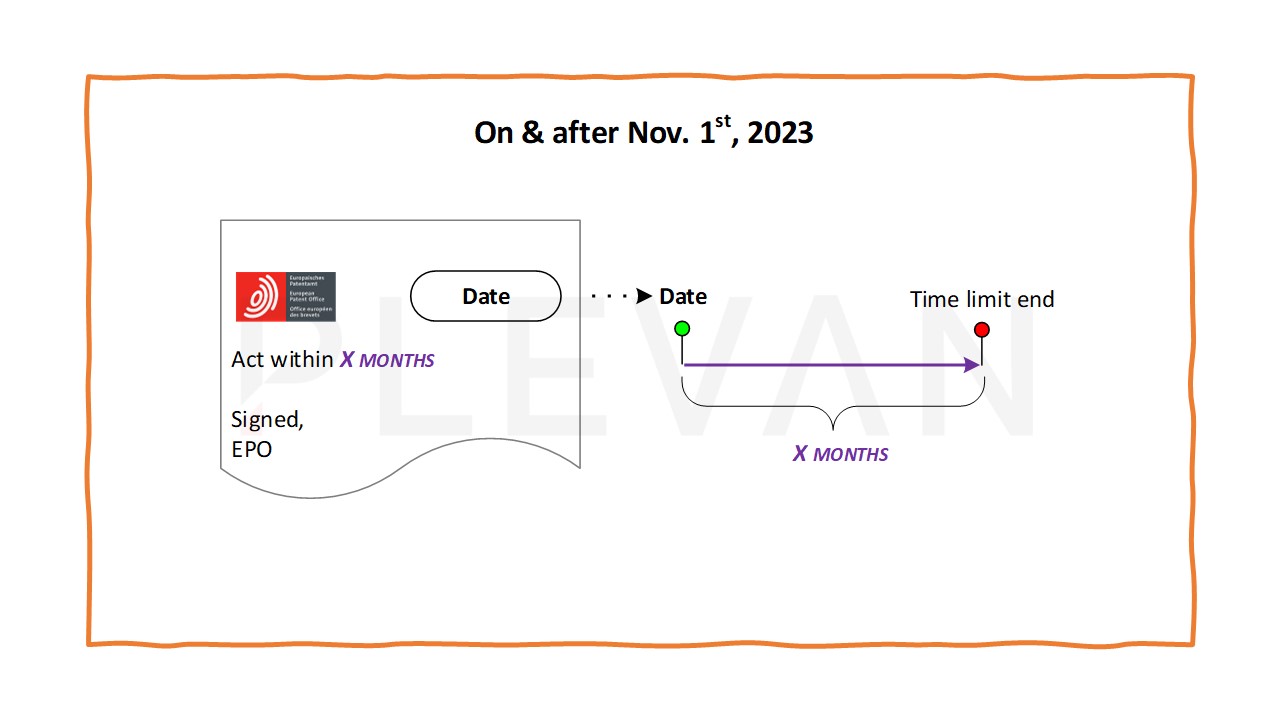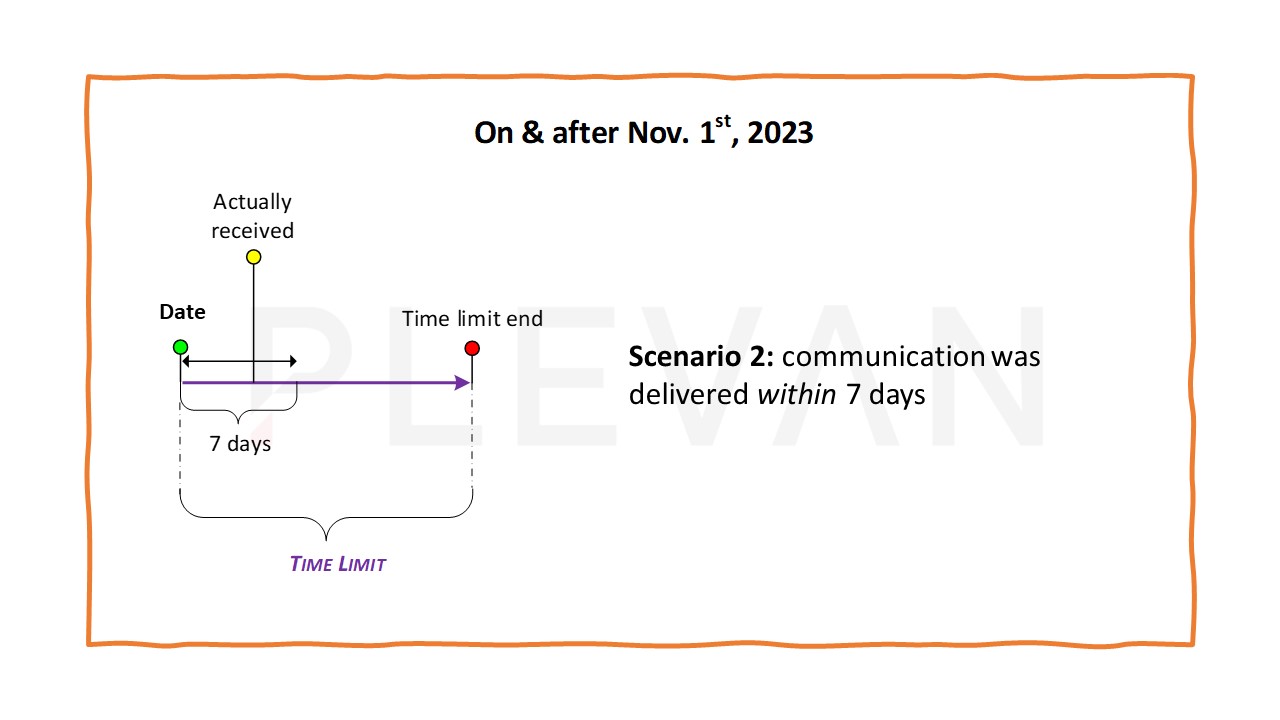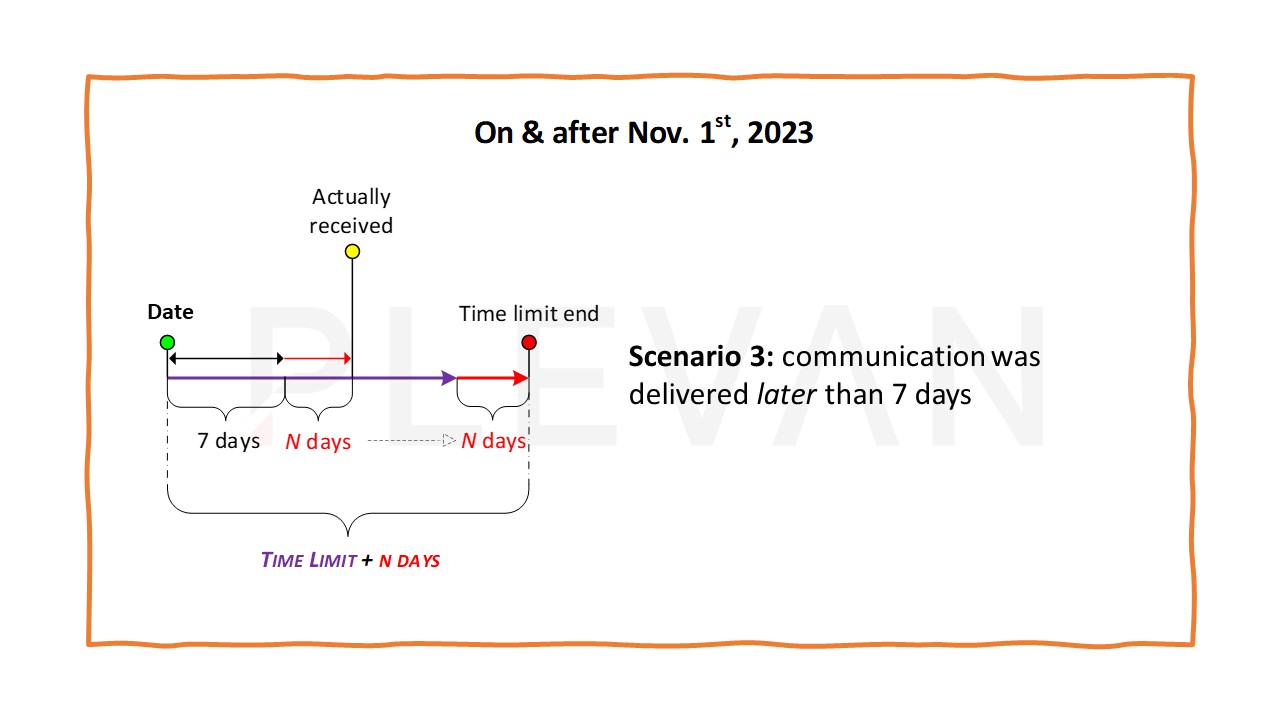This post addresses the now abolished 10-Day-Rule of the European Patent Office EPO, explains the cut-off date and its relevance for today, and how the time limit calculation now works in the post 10-Day-Rule era.
TL;DR:
- EPO’s 10-Day-Rule will be retired on October 31st, 2023
- For EPO communications dated November 1st, 2023 or later, the new Rule 126 EPC applies
- New rule: date of communication is the date when it is considered received
- New rule: if received later than 7 days and EPO provided proof, days in excess of 7 are added to the time limit triggered by communication
I. A Brief History of the 10-Day-Rule
No other rule in the patent domain compared to EPO’s 10-Day-Rule. It was an odd child, born out of the necessity to find a fair solution when office communications had to be snail-mailed across European countries.
The 10-Day-Rule was manifested in Rule 126(2) EPC as follows (excerpt):
Where notification is effected in accordance with paragraph 1, the letter shall be deemed to be delivered to the addressee on the tenth day following its handover to the postal service provider […]
Whenever the EPO sent out a communication, it was presumed delivered on the tenth day–regardless of the actual date of notification. If the communication was received in fewer than ten days (which it always did in our practice), the extra days were considered a bonus. The countdown for the response time only commenced after this 10-day period.
The mechanics of the 10-Day-Rule are shown in Figure 1 below. Time periods triggered with receipt of the communication (e.g. having period of X months) started running ten days after its date.

Fig. 1: the mechanics of EPO’s 10-Day-Rule
I.1 Calendar entries and wrong applications
As straightforward as it may seem, the 10-Day-Rule at the EPO had its fair share of complexities. Here are two examples.
A common error was to append the ten days to the end of the time limit rather than the start.
Why did this matter? Think of weekends and EPO holidays. If the time limit ended on one of these non-working days, you got an extension. But here’s the catch – this leniency didn’t apply to the ten-day addition.
Now, for safety purposes, it was standard practice to notice two dates: the first was a hypothetical early date without the ten days, and the second actual date included those ten days (“Time Limit End” of Fig. 1). While this seemed like a good strategy, it often mislead people into thinking the ten days should be added to the end of that hypothetical early date. And this is where errors crept in. Remember: the rules around weekends and EPO holidays differ for the main deadline and the ten-day addition.
Another typical mistake was the incorrect application of the 10-Day-Rule. This rule notoriously motivated beliefs that time periods mentioned in the notification benefitted from the 10-Day-Rule. However, many time periods are defined in national, regional or international patent law and run entirely independent from the date of notification.
To conclude, despite its compelling extra time, the 10-Day-Rule came with substantial overhead in monitoring its correct calculation and application. One can only speculate that these were some of the driving forces that motivated the EPO to retire the famous 10-Day-Rule.
II. Abolished in 2023: EPO’s 10-Day-Rule
On November 1st, 2023, the popular 10-Day-Rule was abolished. The reasoning for this was likely two-fold. First, it makes due date calculation easier, more in sync with international patent law, and less error-prone. No more false 10-Day-Rule applications, no more false calculations. Second, electronic communication and highly efficient post mail services across all member states take away the very reason behind its implementation.
II.1 Changes to Rule 126 EPC
Shown below is the Rule 126 EPC including the essential amendments that came into force November 1st, 2023.
Note that for readability purposes, some formal changes to this rule, e.g. ‘letter’ to ‘document’, ‘European Patent Office’ to ‘EPO’, had been “accepted” in the making of the tracked version shown in Fig. 2.

Fig. 2: amended Rule 126 EPC, showing essential changes. Yellow marking added.
Let’s take a look at the replacement of ‘tenth day following..’ with ‘the date it bears’ (marked in yellow). This simplification is remarkably powerful. Instead of shortening the time span or implementing any other hybrid solution, the entire calculation step of the former 10-Day-Rule is omitted. Now, it couldn’t be more simple:
deemed to be delivered […] on the date it bears
II.2 Calculation under the new Rule 126 EPC
The resulting one step calculation is shown in Fig. 3 below. It consists of taking the date of the communication and adding the time limit triggered by the communication.
Of course, time limits are always extended when they end on a day where the EPO is closed. You can use our interactive calendar tool and info page to learn all about EPO Holidays.

Fig. 3: due date calculation for communications received on or after Nov. 1st, 2023. The 10-Day-Rule is not applicable
II.3 Which cases will be affected?
Its all about the date mentioned in the communication.
The abolishment of the 10-Day-Rule affects all pending matters before the EPO equally. The new Rule 126 EPC is implemented globally for all communications bearing a date of November 1st, 2023 or later.
Likewise, all communications dated October 31, 2023, or earlier, will fall under the 10-Day-Rule!
II.4 What are the consequences?
The date of the communication is now identical to the starting date of the time limit triggered by this communication.
For many applicants and practitioners, this may feel like losing 10 days for all future communications. However, it also simplifies calculation and office management. The looming threat of false 10-Day-Rule in the calendar is annihilated.
II.5 What if EPO communication has a date that’s in the future?
This is common EPO practice. Examiners tend to pick a date of one or more days in the future to account for internal mail processing delays. In such cases, it is also the date of the communication that sets off the time limit calculation.
II.6 What about delays?
Amended Rule 126 EPC included substantial changes pertaining to delays of notification. Incorporated are several safety mechanisms to avoid adversely affecting applicants and practitioners from the new guidelines.
Good to know: if a communication is lost or late, the burden of proof that it got delivered lies with the EPO.
From this, three scenarios arise:
Scenario 1: EPO cannot prove delivery
In such cases, the EPO will issue an entirely new communication with a new date, which will be the date for calculating the time limits triggered by this communication.
Scenario 2: EPO proves that it delivered within 7 days
If the EPO is able to prove delivery of the communication and shows that delivery occurred within 7 days, nothing changes.
The time limits set forth in the communication are calculated from the date of the communication and run for the originally set duration. This case is shown in Fig. 4 below.

Fig. 4: EPO communication was delivered within 7 days
Scenario 3: EPO proves that it delivered later than 7 days
If the EPO is able to prove delivery of the communication and shows that delivery occurred later than 7 days, there will be an extension to the time limit.
The cut-off day is the seventh day. Counting all days it took to deliver the communication, from the seventh day onwards, this number of days is added to the end of the time limit.
Following the illustration of Fig. 5 below, “N” days refers to the number of days counted from the seventh day onwards.
The new Rule 126(2) EPC states that these additional days extend the time limit. That means the resulting end date is extended, if it falls on a day where the EPO is closed such as a weekend or an EPO holiday.

Fig. 5: EPO communication delivered after 7 days
II.7 What about EPO closing days?
No changes here. All time limits expiring on a day when at least one of the four Receiving Offices of the EPO (Munich, Berlin, Vienna, De Hague) is closed, those time limits are extended to the next day when all four Receiving Offices are open. Learn more about EPO closing days in 2023 and 2024.
II.8 Other ways to extend the time limit
EPO time limits can be extended ‘manually’ in several ways. In some cases, the most straightforward way is to request an extension of time to complete an action.
Alternatively, it may be possible to use the “further processing” route. Simply not acting within time will trigger a “loss of rights”-communication, including a new time limit to complete the action requested in the original communication. To heal the loss of rights, the requested action must be completed and a further processing fee must be paid. This fee is either a fixed fee or a 50% surcharge if the missed action was a fee payment. Note that all missed actions are charged separately.
The “loss of rights” route shall be handled with care. It is intended to be an emergency plan rather than a thoughtful time limit extension strategy. Expert consultation is advised.
III. A Practical Example for the New Rule 126 EPC
Let’s assume that the EPO sends a communication having date of November 15, 2023. In this communication, a time limit to reply is defined as 2 months.
The time limit set for replying to the communication falls under the definitions of Rule 126 EPC.
III.1 Standard Scenario
The communication is deemed notified on November 15, 2023, which is the date of the communication. The last day to reply to this communication is November 15, 2023 plus 2 months, which returns January 15, 2024. January 15, 2024 is a Monday and no EPO Holiday, as shown in our interactive EPO Holiday tool.
III.2 Received earlier or within 7 days
Now, if this communication is received earlier than November 15, 2023, or within 7 days, November 22, 2023, nothing changes. The last day to reply is still January 15, 2024.
III.3 Received later than 7 days
Let’s assume that for whatever reason, it took exceptionally long to receive this communication. Let’s also assume that the EPO could prove delivery of this communication but this proof revealed a delivery date of November 25, 2023.
It follows that the notification took longer than 7 days, namely 10 days. Scenario 3 of Fig. 5 applies.
Counting from the seventh day (November 22, 2023) onwards returns 3 extra days (23rd, 24th, and 25th of November 2023). Those 3 extra days are now added to the end of the 2-month time limit to respond to the Office Action.
Adding 2 months plus 3 days to the original communication date of November 15, 2023 returns January 18, 2024 as the last day to reply to the communication. Since this new last day to reply to the communication is a Thursday and a no EPO holiday, it is not extended.
IV. How we can help
Calculating and keeping track of due dates is always more complicated than meets the eye. It takes time and constant effort to manage due dates, especially in the field of registered IP rights.
We are happy to assist you in any questions you might have pertaining to due date calculations for your cases pending before the European Patent Office. We invite you to learn more about our service principles and to schedule a free initial consultation.



